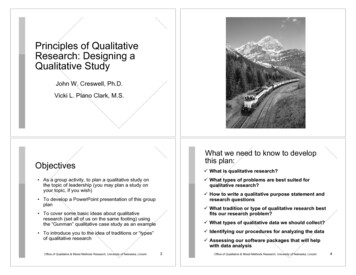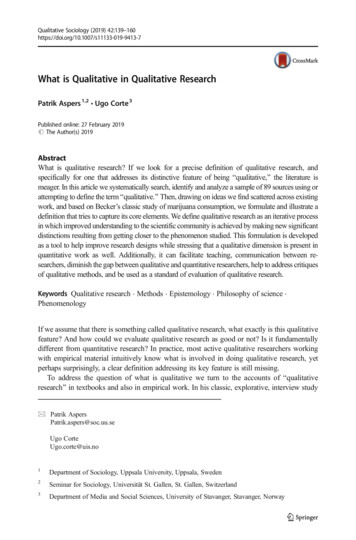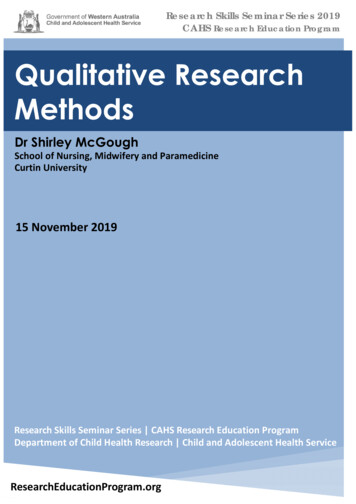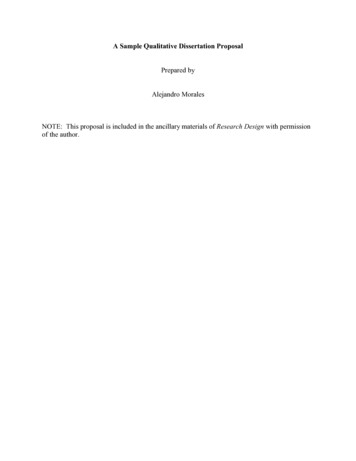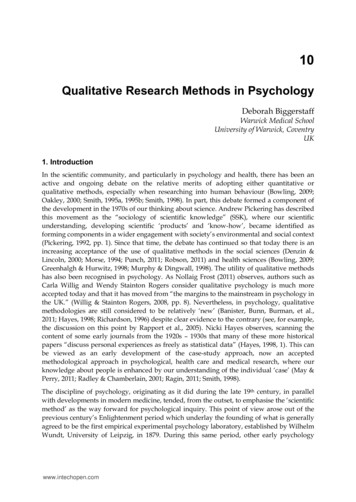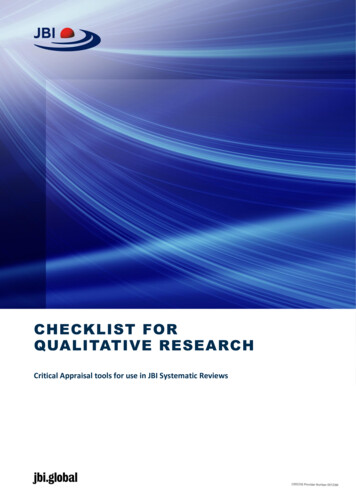
Transcription
CHECKLIST FORQUALITATIVE RESEARCHCritical Appraisal tools for use in JBI Systematic Reviews
INTRODUCTIONJBI is an international research organisation based in the Faculty of Health and Medical Sciences at theUniversity of Adelaide, South Australia. JBI develops and delivers unique evidence-based information,software, education and training designed to improve healthcare practice and health outcomes. With over70 Collaborating Entities, servicing over 90 countries, JBI is a recognised global leader in evidence-basedhealthcare.JBI Systematic ReviewsThe core of evidence synthesis is the systematic review of literature of a particular intervention, conditionor issue. The systematic review is essentially an analysis of the available literature (that is, evidence) and ajudgment of the effectiveness or otherwise of a practice, involving a series of complex steps. JBI takes aparticular view on what counts as evidence and the methods utilised to synthesise those different types ofevidence. In line with this broader view of evidence, JBI has developed theories, methodologies andrigorous processes for the critical appraisal and synthesis of these diverse forms of evidence in order to aidin clinical decision-making in healthcare. There now exists JBI guidance for conducting reviews ofeffectiveness research, qualitative research, prevalence/incidence, etiology/risk, economic evaluations,text/opinion, diagnostic test accuracy, mixed-methods, umbrella reviews and scoping reviews. Furtherinformation regarding JBI systematic reviews can be found in the JBI Evidence Synthesis Manual.JBI Critical Appraisal ToolsAll systematic reviews incorporate a process of critique or appraisal of the research evidence. The purposeof this appraisal is to assess the methodological quality of a study and to determine the extent to which astudy has addressed the possibility of bias in its design, conduct and analysis. All papers selected forinclusion in the systematic review (that is – those that meet the inclusion criteria described in the protocol)need to be subjected to rigorous appraisal by two critical appraisers. The results of this appraisal can thenbe used to inform synthesis and interpretation of the results of the study. JBI Critical appraisal tools havebeen developed by the JBI and collaborators and approved by the JBI Scientific Committee followingextensive peer review. Although designed for use in systematic reviews, JBI critical appraisal tools can alsobe used when creating Critically Appraised Topics (CAT), in journal clubs and as an educational tool. JBI, 2020. All rights reserved. JBI grants use of thesetools for research purposes only. All other enquiriesshould be sent to jbisynthesis@adelaide.edu.au.Critical Appraisal Checklist for Qualitative Research - 2
JBI CRITICAL APPRAISAL CHECKLIST FORQUALITATIVE RESEARCHReviewer DateAuthor Year Record NumberYesNoUnclearNotapplicable1.Is there congruity between the stated philosophicalperspective and the research methodology? 2.Is there congruity between the research methodologyand the research question or objectives? 3.Is there congruity between the research methodologyand the methods used to collect data? 4.Is there congruity between the research methodologyand the representation and analysis of data? 5.Is there congruity between the research methodologyand the interpretation of results? 6.Is there a statement locating the researcher culturallyor theoretically? 7.Is the influence of the researcher on the research, andvice- versa, addressed? 8.Are participants,represented?adequately 9.Is the research ethical according to current criteria or,for recent studies, and is there evidence of ethicalapproval by an appropriate body? 10. Do the conclusions drawn in the research report flowfrom the analysis, or interpretation, of the data? Overall appraisal:Includeandtheir voices,Exclude Seek further info Comments (Including reason for exclusion) JBI, 2020. All rights reserved. JBI grants use of thesetools for research purposes only. All other enquiriesshould be sent to jbisynthesis@adelaide.edu.au.Critical Appraisal Checklist for Qualitative Research - 3
DISCUSSION OF CRITICAL APPRAISAL CRITERIAHow to cite: Lockwood C, Munn Z, Porritt K. Qualitative research synthesis: methodological guidance forsystematic reviewers utilizing meta-aggregation. Int J Evid Based Healthc. 2015;13(3):179–187.1.Congruity between the stated philosophical perspective and the research methodologyDoes the report clearly state the philosophical or theoretical premises on which the study isbased? Does the report clearly state the methodological approach adopted on which thestudy is based? Is there congruence between the two? For example:A report may state that the study adopted a critical perspective and participatory actionresearch methodology was followed. Here there is congruence between a critical view(focusing on knowledge arising out of critique, action and reflection) and action research (anapproach that focuses on firstly working with groups to reflect on issues or practices, thenconsidering how they could be different; then acting to create a change; and finally identifyingnew knowledge arising out of the action taken). However, a report may state that the studyadopted an interpretive perspective and used survey methodology. Here there isincongruence between an interpretive view (focusing on knowledge arising out of studyingwhat phenomena mean to individuals or groups) and surveys (an approach that focuses onasking standard questions to a defined study population); a report may state that the studywas qualitative or used qualitative methodology (such statements do not demonstrate rigourin design) or make no statement on philosophical orientation or methodology.2.Congruity between the research methodology and the research question or objectivesIs the study methodology appropriate for addressing the research question? For example:A report may state that the research question was to seek understandings of the meaning ofpain in a group of people with rheumatoid arthritis and that a phenomenological approachwas taken. Here, there is congruity between this question and the methodology. A report maystate that the research question was to establish the effects of counselling on the severity ofpain experience and that an ethnographic approach was pursued. A question that tries toestablish cause-and effect cannot be addressed by using an ethnographic approach (asethnography sets out to develop understandings of cultural practices) and thus, this would beincongruent. JBI, 2020. All rights reserved. JBI grants use of thesetools for research purposes only. All other enquiriesshould be sent to jbisynthesis@adelaide.edu.au.Critical Appraisal Checklist for Qualitative Research - 4
3.Congruity between the research methodology and the methods used to collect dataAre the data collection methods appropriate to the methodology? For example:A report may state that the study pursued a phenomenological approach and data wascollected through phenomenological interviews. There is congruence between themethodology and data collection; a report may state that the study pursued aphenomenological approach and data was collected through a postal questionnaire. There isincongruence between the methodology and data collection here as phenomenology seeks toelicit rich descriptions of the experience of a phenomena that cannot be achieved throughseeking written responses to standardized questions.4.Congruity between the research methodology and the representation and analysis of dataAre the data analyzed and represented in ways that are congruent with the statedmethodological position? For example:A report may state that the study pursued a phenomenological approach to explore people’sexperience of grief by asking participants to describe their experiences of grief. If the textgenerated from asking these questions is searched to establish the meaning of grief toparticipants, and the meanings of all participants are included in the report findings, then thisrepresents congruity; the same report may, however, focus only on those meanings that werecommon to all participants and discard single reported meanings. This would not beappropriate in phenomenological work.5.There is congruence between the research methodology and the interpretation of resultsAre the results interpreted in ways that are appropriate to the methodology? For example:A report may state that the study pursued a phenomenological approach to explore people’sexperience of facial disfigurement and the results are used to inform practitioners aboutaccommodating individual differences in care. There is congruence between the methodologyand this approach to interpretation; a report may state that the study pursued aphenomenological approach to explore people’s experience of facial disfigurement and theresults are used to generate practice checklists for assessment. There is incongruencebetween the methodology and this approach to interpretation as phenomenology seeks tounderstand the meaning of a phenomenon for the study participants and cannot beinterpreted to suggest that this can be generalized to total populations to a degree wherestandardized assessments will have relevance across a population. JBI, 2020. All rights reserved. JBI grants use of thesetools for research purposes only. All other enquiriesshould be sent to jbisynthesis@adelaide.edu.au.Critical Appraisal Checklist for Qualitative Research - 5
6.Locating the researcher culturally or theoreticallyAre the beliefs and values, and their potential influence on the study declared? For example:The researcher plays a substantial role in the qualitative research process and it is important,in appraising evidence that is generated in this way, to know the researcher’s cultural andtheoretical orientation. A high quality report will include a statement that clarifies this.7.Influence of the researcher on the research, and vice-versa, is addressedIs the potential for the researcher to influence the study and for the potential of the researchprocess itself to influence the researcher and her/his interpretations acknowledged andaddressed? For example:Is the relationship between the researcher and the study participants addressed? Does theresearcher critically examine her/his own role and potential influence during data collection?Is it reported how the researcher responded to events that arose during the study?8.Representation of participants and their voicesGenerally, reports should provide illustrations from the data to show the basis of theirconclusions and to ensure that participants are represented in the report.9.Ethical approval by an appropriate bodyA statement on the ethical approval process followed should be in the report.10. Relationship of conclusions to analysis, or interpretation of the dataThis criterion concerns the relationship between the findings reported and the views or wordsof study participants. In appraising a paper, appraisers seek to satisfy themselves that theconclusions drawn by the research are based on the data collected; data being the textgenerated through observation, interviews or other processes. JBI, 2020. All rights reserved. JBI grants use of thesetools for research purposes only. All other enquiriesshould be sent to jbisynthesis@adelaide.edu.au.Critical Appraisal Checklist for Qualitative Research - 6
effectiveness research, qualitative research, prevalence/incidence, etiology/risk, economic evaluations, text/opinion, diagnostic test accuracy, mixed-methods, umbrella reviews and scoping reviews. Further information regarding JBI systematic reviews can be found in the JBI Evidence Synthesis Manual. JBI Critical Appraisal Tools
